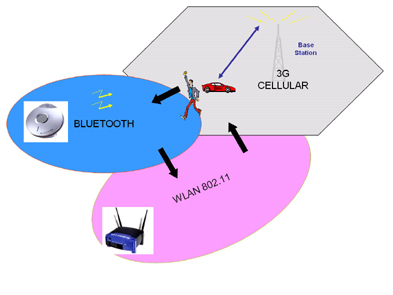VoIP to cell to WiFi to WLAN on one device? Yes!


Image is from the Mobile & Portable Radio Research Group at Virginia Tech.
At an Internet telephony conference last month, I wound up talking to a guy about mobile devices.
"What would be your ultimate handset," I asked him.
He said something to the effect of a device that could seamlessly switch call and transmission modes to the one most suitable for its location. Say, VoIP here, cell there, WiFi if you are at or close to a hotspot.
We then talked about some of the standards-based, regulatory and carrier competition factors that could delay such a technology from coming into being. While those challenges are real, they are more formidable than actually making such a ubiquitous multi-mode handset work.
The technology for making this all happen is called "cognitive radios." Briefly defined, this is a smart wireless communications technology that will be able to locate and then connect with any nearby open radio frequency to serve the user.
On stands now, the March, 2006 issue of Scientific American magazine explains how the technology will work.
"Opportunistic communications connections using cognitive radio (CR) technology operating via the wireless Web will keep commuters in contact no matter the location or the transmission conditions,," article author Steven Ashley writes. "Along the way to work, the CR senses the local radio environment and chooses the best free wireless links to complete calls."
Ashley then lays out six plausible scenarios for CR-driven handoffs as a commuter with a CR-enabled handset drives from home to work:
1. Near home, the CR connects to the owner's home radio frequency network for VoIP and web services.
2. Slightly farther away, the CR detects a neighbor's wireless local area network offering "spectrum cash"- a barter deal for future access to open bandwidth- to connect to an Internet service provider.
3. A low-capacity cellular phone provider rents 30 seconds of airtime to the CR as the commuter drives through the local area.
4. The commuter's CR relays a call from a police force to its base in exchange for future use of open police-frequency bandwidth, adding city blocks of emergency radio spectrum.
5. The CR rents a WLAN capacity from a local utility for two minutes as it nears the power plant.
6. As the commuter reachesthe workplace, the CR identifies several nearby WLANs, switching to the corporate WLAN for the day's business, to a cafe's wireless network at break time and then a restaurant's WLAN during after hours.
But wait. We're not there yet. Entrenched interests will need to be mollified.
As Scientific American's Steven Ashley so accurately puts it:
The decisions concerning the future of cognitive radio technology are shaping up as a battle between two giant business sectors: the cell-phone and telecommunications industry versus "the Internet industry," which includes Microsoft, Intel, Google, Internet service providers and consumer computer firms. Although entrenched interests may resist it, progress toward cognitive radio seems likely because the relative chaos and inflexibility of unregulated radio bands (such as those now handling instrumentation, scientific and medical devices) could be avoided. Ultimately, smart operator etiquette based on cognitive radio technology will turn gigahertz of underused spectrum into wideband connectivity for many users.
Gosh, I hope so. The internecine warfare of today is thwarting so much necessary technology from becoming reality. What's needed is a strong government hand unbeholden to one set of interests over the other.